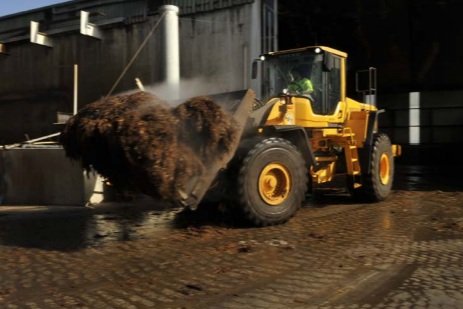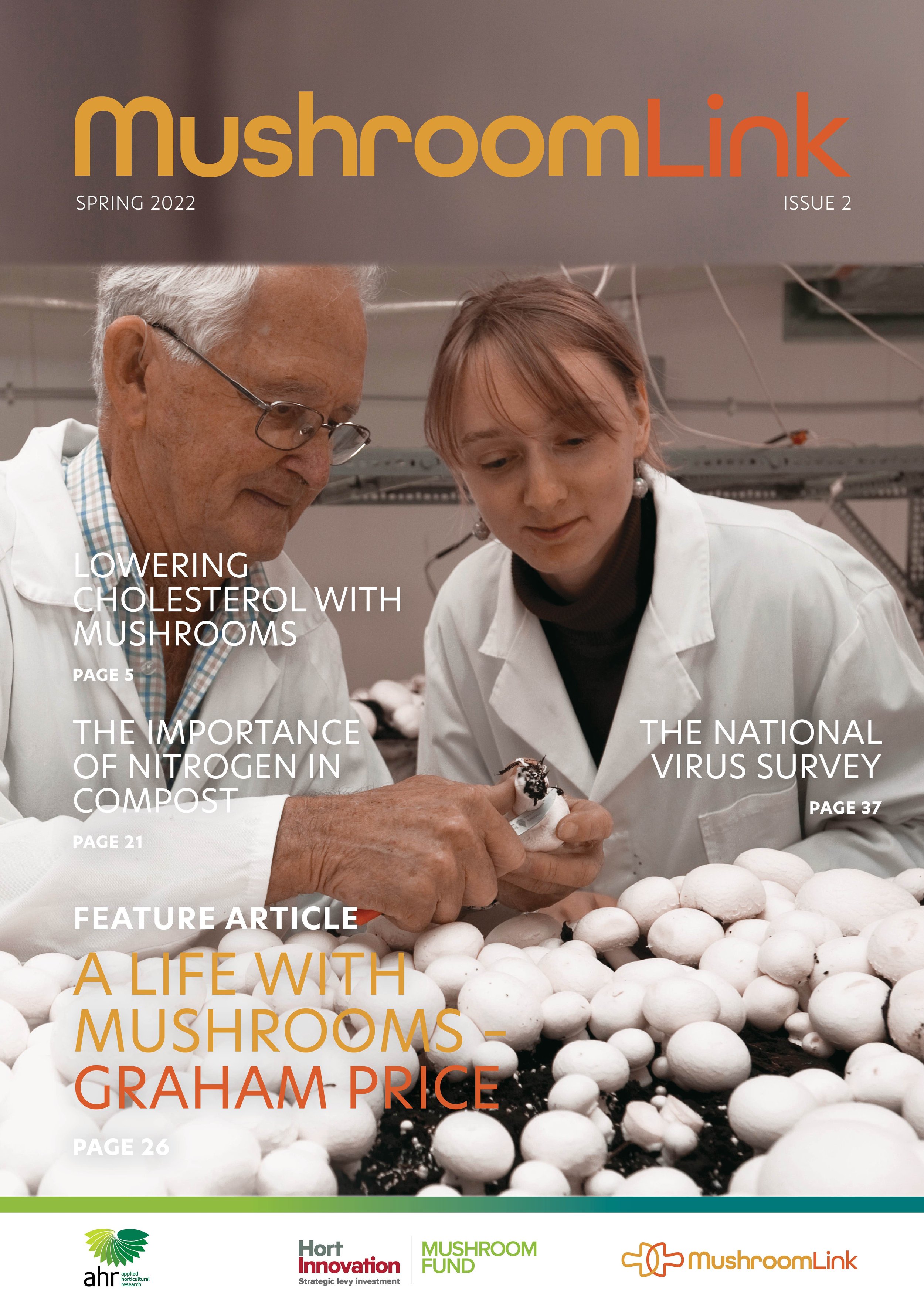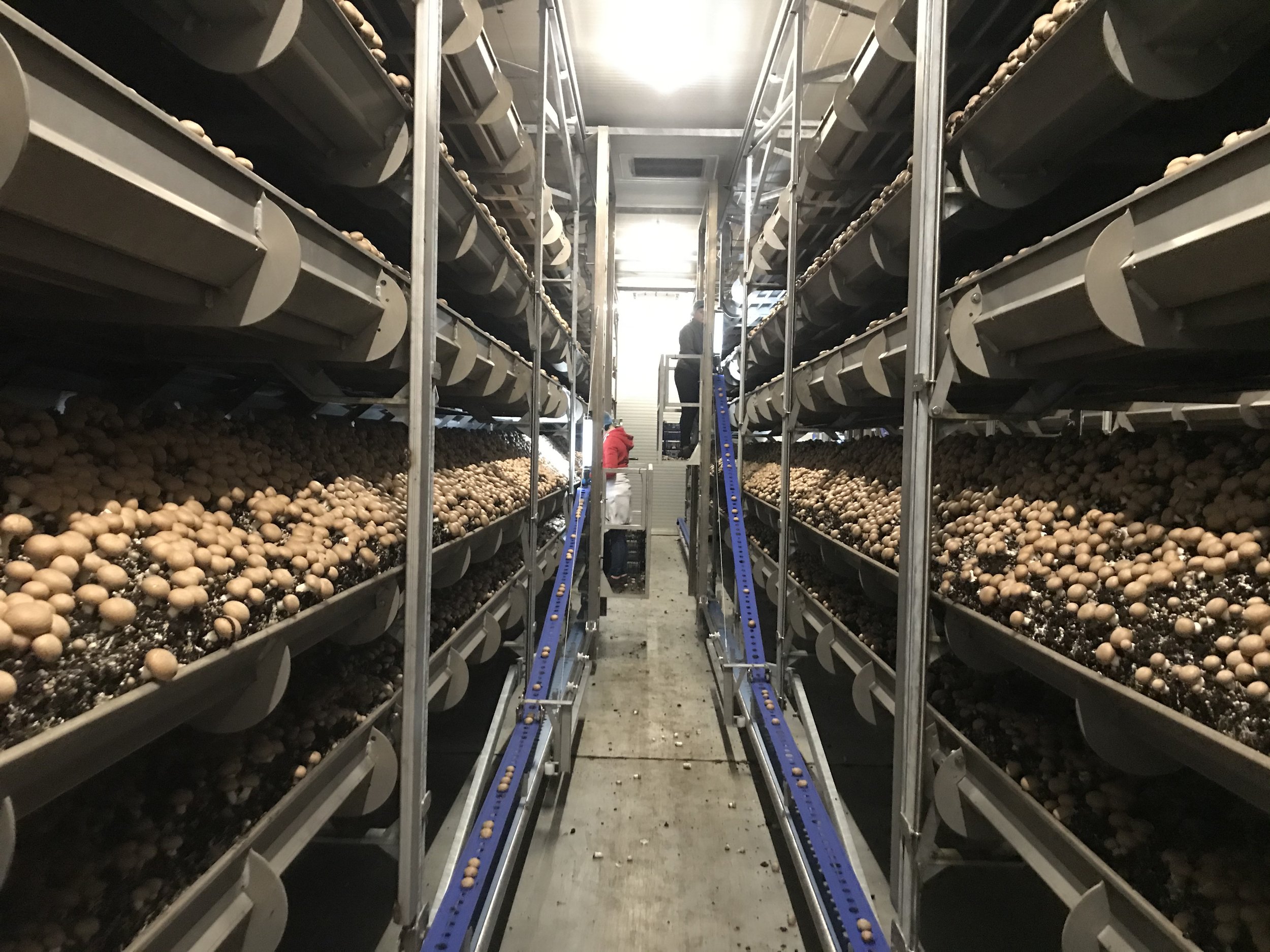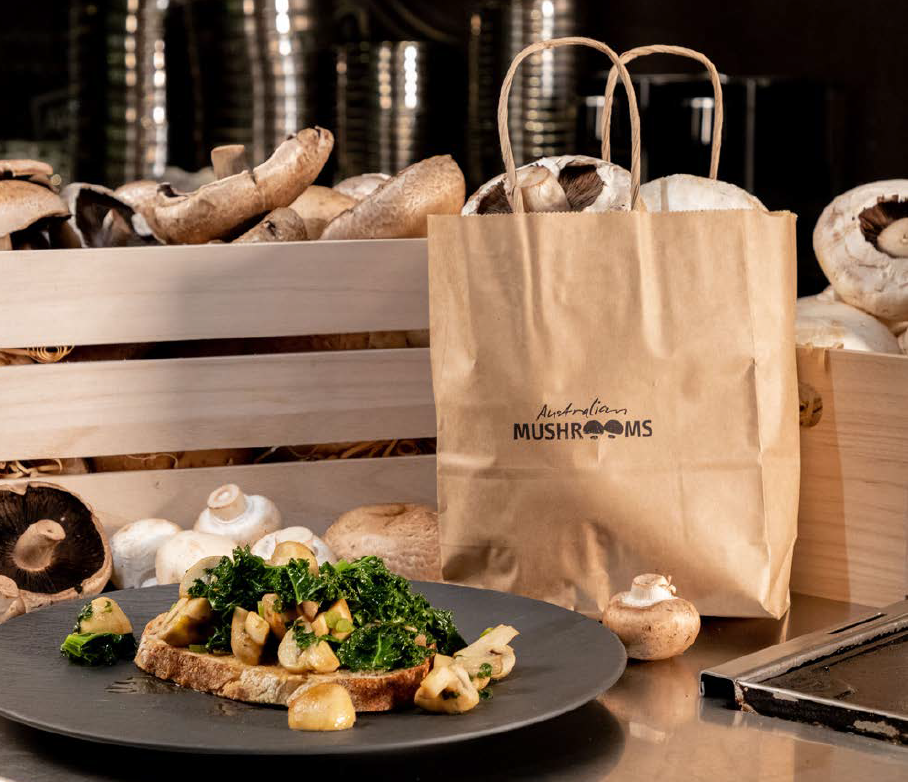Collaborative Marketing Workshop with the Mushroom Industry
By Emma Day, Marketing Manager HIA
Hort Innovation’s commitment to working more closely with the mushroom industry in matters relating to marketing came to realisation in early September, with the first co-design workshop. Earlier in the year the AMGA were invited to identify three to four industry representatives to be a part of the co-design panel.
The outcomes of the workshop will inform the development of evidence-based marketing strategies for 23-26, and an annual marketing investment plan for F23, ensuring that these plans are built on robust analysis, contain actions that clearly link to demand creation and facilitate transparent measurement and evaluation of actions and impact.
The workshops took place in Sydney, with representatives from the Mushroom Industry joining HIA Marketing, Data and Insights, and Industry Strategic Partnership personnel for two busy and productive days to jointly develop the marketing plans. The workshops were run by Jane Smith and Kylie Hudson, General Managers Marketing, with presentations from many of the HIA Mushroom team.
The Mushroom Industry was represented by Leah Bramich, GM AMGA, Kyle Davies, Marland Mushrooms, Georgia Beattie, Bulla Park, Tim Archibald, White Prince, with apologies from Elisa Siliato from Costa.
Day One focused on a big data download and share. Presentations were given on the broader market context of consumer’s lives, industry feedback on important issues, the retail and trading environment in which we all operate, the consumer and shopper, needs and occasions, and a FY22 activity evaluation. As a group we then prioritised our learnings and implications and agreed on the focus for our plan and who we should target.
Day Two we regrouped and then defined the big shifts required from consumers to grow the Mushroom category and set our vision and goals according to what our category would stand for in the minds of consumers. With clear objectives, we could define the key strategic pillars which will underpin the activities arising from this marketing plan.
A brainstorming session resulted in a detailed one-year plan, as well as a more future-looking horizon plan. This was followed by the business of budgeting and how we might allocate the marketing funds for year one.
With all this valuable input, the HIA marketing team will now create the detail of the plan around our agreed vision, goals, and strategic pillars. The plan will be presented to the SIAP on 20 September for approval.
In the meantime, the first part of the plan details the 12 key facts gained from the data download on day one. These insights are the key pieces of data that drove our decision making as a team, and we thought worth sharing with the industry.
Fact sheet: Mushroom nutrition and health messages
While we know that mushrooms are good for our health, making claims to this effect is a little more complicated.
Nutritional claims linked to food are highly regulated and statements need to be carefully crafted.
To help growers, chefs, personal trainers, social medial influencers, or anyone wanting to spruik mushrooms, the Australian Mushroom Growers Association (AMGA) teamed up with nutrition specialists to create a comprehensive set of statements that complies with strict FSANZ guidelines.
The AMGA teamed up with nutrition specialists to create a comprehensive guide about what you can actually say about mushrooms that complies with the strict guidelines.
This AMGA funded project set out to create a list of pre-crafted statements that can be used by growers looking to create their own marketing pathways/business plans, personal trainers, social media influences, celebrity chef and more
Divided into key categories of overarching statements, statements by health outcomes, and statement about diet type. Uses of the guide can use this resource to make confident claims.
This fact sheet has been created to outline the range of health benefits that can be attributed to the nutrients found in mushrooms. The statements in this document are a more consumer-friendly version of permitted nutrition and health claims that comply with FSANZ Code.
Additionally, consumer research was recently undertaken (which is also available in the grower portal), which tells us that health claims about mushrooms and immunity, as well as calcium absorption are the most likely to resonate and prompt purchase, and therefore are good claims to consider in any of your communications.
My mushroom toast
The #MyMushroomToast campaign is up and running! And to celebrate the launch, media and foodie influencers were invited to a #MyMushroomToast cooking masterclass hosted by internationally known chef Jason Roberts.
National mushroom virus survey
The vast majority of mycoviruses – the viruses which are naturally widespread throughout both cultivated and wild fungi – cause no problems to their host. But occasionally, combinations of virus particles interact, causing quality and yield issues.
Understanding price elasticity in the Australian mushroom industry
The Australian mushroom industry is a significant horticultural sector, with potential to expand in the future. Recent data from NielsenIQ, in partnership with Hort Innovation, reveals that almost 80% of households now purchase mushrooms. However, the role of price in changing demand, as well as potentially reaching new consumers, is not well understood.
The power of mushroom waste
Growing mushrooms inevitably generates waste. There is spent compost, cut stems, unsaleable mushrooms and drain water all to dispose of. Finding ways to turn so-called waste into an income generating resource has been a puzzle, but one where there may now be solutions.
Graham Price and the history of Hawkesbury mushroom industry
Graham Price hand turning compost for his mushroom farm
There wouldn’t be many who have been in the Australian mushroom industry more than a few years who haven’t come across Graham Price. Along with Rob Tolson, and other early trailblazers such as Roy Sanders, Raymon Mas and John Miller, Graham was one of those who helped take the Australian industry from its rudimentary beginnings to the mechanised, highly technical business that it is today.
Poultry litter - More than just a nitrogen source
The well-documented cholesterol-lowering effect of oats has been certified by nutritional regulators
globally since the late 1990s. Subsequent studies and clinical trials have shown consistent results that confirm, and even boost, the original claims. This high-level health claim has driven an increase in the consumption of oats globally1. Beta-glucan, the compound responsible for lowering cholesterol, is famously present in oat and barley grains. However, its presence in mushrooms is less well known.
Feeding mushrooms - The ‘ins’ and ‘outs’ of nitrogen in mushroom compost
While protein is a valuable portion of the dry matter (DM) in mushrooms, its content is quite variable, ranging from 14-30%. Dry matter itself ranges from a low as 7% up to 14%. High DM content and, therefore, high protein content, is associated with firmer mushrooms and improved shelf life.
Can mushrooms really help lower our cholesterol?
The well-documented cholesterol-lowering effect of oats has been certified by nutritional regulators globally since the late 1990s. Subsequent studies and clinical trials have shown consistent results that confirm, and even boost, the original claims. This high-level health claim has driven an increase in the consumption of oats globally1. Beta-glucan, the compound responsible for lowering cholesterol, is famously present in oat and barley grains. However, its presence in mushrooms is less well known.
The well-documented cholesterol-lowering effect of oats has been certified by nutritional regulators
globally since the late 1990s. Subsequent studies and clinical trials have shown consistent results that confirm, and even boost, the original claims. This high-level health claim has driven an increase in the consumption of oats globally1. Beta-glucan, the compound responsible for lowering cholesterol, is famously present in oat and barley grains. However, its presence in mushrooms is less well known.
Case Study: Graham Price and the history of the Hawkesbury mushroom industry
Graham Price hand turning compost at his mushroom farm
There wouldn’t be many who have been in the Australian mushroom industry more than a few years who haven’t come across Graham Price. Along with Rob Tolson, and other early trailblazers such as Roy Sanders, Raymon Mas and John Miller, Graham was one of those who helped take the Australian industry from its rudimentary beginnings to the mechanised, highly technical business that it is today.
MushroomLink Bulletin September 2022
In this edition:
FEATURE: Spring MushroomLink out now
MARKETING: September marketing news
RESEARCH: Conference speaker spotlight
WATCH: AHR webinar - spent mushroom compost as casing soil
Adding mushrooms to the menu - Where are the opportunities?
To elevate mushrooms in the minds of food professionals, highlighting their benefits through impactful education and engagement could bring them out of the shadows and into the limelight. The levy-funded research project MU20003: Educating the food industry about Australian mushrooms sought to identify and understand the existing barriers to featuring more mushrooms on Australian menus.
MushroomLink Magazine Issue 02
The second issue of the new MushroomLink magazine is now available. Please contact admin@ahr.com.au to organise a hard copy version of the magazine or be put on the mailing list.
Click here to access a digital copy
Articles
Can mushrooms really help lower our cholesterol?
Adding mushrooms to the menu - where are the opportunities?
Growing the future together - the 2022 AMGA conference
Feeding mushrooms - the ‘ins’ and ‘outs’ of nitrogen in compost
Poultry litter - more than just a nitrogen source
Graham Price and the history of the Hawkesbury mushroom industry
Understanding price elasticity in the mushroom industry
GROWING THE FUTURE TOGETHER
The 2022 AMGA conference
By Dr Jenny Ekman
At the end of October, the mushroom industry will meet in Adelaide for the first industry conference in several years. With a diverse speaker program, the conference provides a unique opportunity to learn about new advances in research, farm practice and marketing initiatives, as well as offering great networking opportunities.
This year, the AMGA conference will host suppliers, growers, farm owners and well-respected national and international speakers.
Following farm tours on day one, day two of the conference (Thursday 27 October) is dedicated to
international speakers. A wide range of presentations will focus on topics critical to the ongoing sustainability of the industry, including harvest mechanisation, new variety development and alternative casing materials.
One of the great range of international guests are profiled below.
Picking the best from harvest practices
Mushrooms are already a technology-intense crop. More than any other, they rely on precise control of
substrate, climate, nutrition, and irrigation. Many aspects have been mechanised, with computer controlled compost production, bulk phase 3 compost, automatic casers and fillers and many other technological aids.
However, the most important part of cropping – harvest – is still entirely done by hand. Many growers were already struggling with rising labour costs before COVID-19.
In recent months, the difficult situation resulting from numerous unfilled positions has been exasperated by illness-derived labour shortages. Added to the major cost of labour to growers is now the almost daily worry of worker availability.
For more than 30 years engineers have been trying to develop a robotic mushroom harvester. This is no easy task. Mushrooms need to be picked gently, trimmed appropriately, and placed into grades according to size and shape. A firm touch or sharp edge can easily disfigure or bruise mushrooms. Furthermore, as mushrooms are not regularly spaced on the beds, picking single mushrooms from clustered groups poses another special challenge.
Initial robotic harvester designs had limited success. Silsoe Research Institute developed an early robotic harvester in 19931. A suction cap attached to each mushroom, which then twisted and lifted the mushroom. While it could locate 84% of mushroom targets, only 57% were picked successfully. Overlapped or closely packed mushrooms were the most difficult to pick.
Technology has come a long way since the 1990s, and so has the search for robotic mushroom harvesting. A quick Google search reveals at least 10 companies (and universities) involved in developing commercial harvest technology for mushroom farms.
Any such technology is inevitably going to be capital-intensive. A potentially less expensive approach is to develop ways to increase efficiency of human pickers. This may mean using single layer beds, or moveable and/or tilting trays.
One company working on both options is GTL Europe. The company was initially formed in 1994 by Jack Lemmen as a tiny start-up in a shed beside his parents’ house. In 2013 he merged with three companies: Geraedts, Thilot and Lemmen. This has given the larger group expertise in air handling and control, composting and growing equipment, and waste management.
GTL Europe is now a globally recognised company involved in all levels of mushroom cultivation. It offers solutions to compost producers and farms including construction design, climate control systems, machinery, and automation solutions.
Jack Lemmen will be presenting at the 2022 AMGA conference on some of the latest developments in automation on mushroom farms. According to Jack, “The tilting shelves system was just the beginning. It is really the starting point towards a fully integrated harvesting system. Technological developments such as robotics and artificial intelligence are creating an array of opportunities to further optimise the harvesting process.”
Huge improvements have been made in scanning, grading, and packing equipment for many fresh horticultural industries. Perhaps it is time for a great leap forward for mushrooms. Jack is certainly well qualified to give insight into what new technologies are becoming available, and potential benefits for the mushroom industry. It is certain to be a fascinating subject.
This is an excerpt for the MushroomLink Spring 2022 magazine, click here to read the full article and publication
My Mushroom Toast
The #MyMushroomToast campaign is up and running! And to celebrate the launch, media and foodie influencers were invited to a #MyMushroomToast cooking masterclass hosted by internationally known chef Jason Roberts.
Early in September, foodie social media influencers - with a combined following of over 255K - and reps from top-tier media outlets including Delicious, Taste and Eativity met in Sydney’s Fish Markets Cooking School to learn how to cook, prep and experiment with the Mighty Mushie.
Attendees cooked two delicious #MyMushroomToast dishes - Miso Butter Mushrooms and Cavolo Nero on Toasted Ciabatta and Balsamic Mushrooms on Sourdough Toast with Blistered Cherry Tomatoes, Feta and Basil Oil. By working through the recipes together, the budding mushroom advocates learnt how quick and easy it is to prep and cook with mushrooms.
To ensure maximum amplification of the event, the Hort Innovation marketing team worked with their production crew to capture extra imagery and video footage. These resources will be used throughout Australian Mushrooms’ social channels and other PR Initiatives.
Following the mushroom cooking class, Jason Roberts and Leah Bramich ran a Q&A with attendees. They answered questions and gave insight around the numerous nutritional benefits of mushrooms, the distinct umami flavour profile, and interesting facts around how mushrooms grow in a sustainable way.
The event was a great success with attendees really engaging with this most versatile of ingredients.
We are looking forward to following the #MyMushrroomToast hashtag over the next couple of months to see everyone’s culinary creations.
To encourage Aussie cafés to hero mushrooms in more dishes, Australian Mushrooms is running a competition from September to October to determine the best #MyMushroomToast, with a major prize incentive to the café that produces Australia’s Best Mushrooms on Toast dish. To read more about this initiative, see page 25 of the winter edition of MushroomLink, Mushrooms on Toast Set to Infiltrate Café Culture.
The video footage of the event can be viewed at australianmushrooms.com.au/foodservice or scan the QR code.
MU21006 - Recycling spent mushroom substrate (SMS) for fertiliser in a circular economy
Key research provider: Frontier Ag & Environment
What's it all about?
This investment is developing models for a spent mushroom substrate (SMS) circular economy by improving the value-proposition of SMS for the end-user (primarily grain growers). The circular economy models for SMS recycling will be presented as practical case studies to equip Australian mushroom growers with an improved understanding of the options available for recycling SMS.
Previous research has found that SMS may be undervalued and highlighted the reliance of the Australian mushroom industry on wheaten straw as one of the main inputs in the production of mushroom growing substrate.
The effects of drought, climate change, changed farming practices, and increased competition from the feedstock industry have reduced the availability of wheaten straw to mushroom growers and have driven up prices.
The application of circular economy principles has the potential to strengthen linkages between the mushroom industry and grain growers. Opportunities also exist to enhance the value of SMS as a revenue stream for the mushroom industry and as an input to the sustainable production of grains. Enhanced value for the mushroom industry is likely to be found in higher returns achieved for a value-added SMS product in the marketplace.
The research team will:
Review past research on SMS to establish its value proposition as a value-added product
Map SMS supplies with potential end-users of SMS
Conduct intensive consultation and demonstration trials with mushroom growers and agriculture users who are end-users of SMS.
MU21004 - Marsh Lawson Mushroom Research Centre of Excellence
Key research provider: The University of Sydney and Applied Horticultural Research
What's it all about?
Following on from the previous levy investment Marsh Lawson Research Centre (MU16004), which began in 2017, this project supports the running and development of the Marsh Lawson Mushroom Research Centre (MLMRC) at the University of Sydney. The MLMRC is a world-class facility dedicated to mushrooms, and the research that takes place there will help the mushroom industry drive innovation, adopt best practices and tackle issues while encouraging new expertise in the industry.
There is a steering committee for the centre and its work, which has aligned the operation of the MLMRC to the Mushroom Fund’s Strategic Investment Plan and will help progress research needs and ideas that will be fulfilled through the centre.
The main objectives of the project remain strongly aligned with those of the previous project:
Maintenance and management of the current Marsh Lawson Mushroom Research Unit at the Darlington Campus, University of Sydney, to promote and carry out active research on all aspects of the growing and cropping of mushrooms.
Provision of research leadership to the mushroom industry, consulting with the industry to prioritise industry research needs through the MLMRC Steering Committee and providing targeted advice on mushroom-related research to the Mushroom Strategic Investment Advisory Panel (SIAP).
Supporting the transition to a new mushroom research facility at a site to be identified when this becomes available.
MU21008 - Mushroom industry conference
Key research provider: Australian Mushroom Growers' Association
What's it all about?
This investment delivers a national mushroom industry conference which will take place over three days from 26-28 October 2022. The conference will improve the communication of information to mushroom growers regarding mushroom production, sustainability, health benefits, consumer marketing and more, with the ultimate outcome of contributing to building a stronger, more resilient Australian mushroom industry
For more information on the conference, visit the Australian Mushroom Growers’ Association website here.
MT21202 - Consumer usage and attitude tracking 2022/23
Key research provider: Fifty-Five Five
What's it all about?
This investment provides a category tracking service to allow various horticultural categories to better understand consumer usage and attitudes and the effectiveness of marketing campaigns.
The insights gained from this program will seek to answer questions such as:
How do consumer trends and movements in behaviours, usage and attitudes to fresh produce change over time?
How do these trends and evolving expectations of consumers inform future demand opportunities for both the whole-of-horticulture, as well as individual industries?
What perception metrics drive usage and purchase?
What are the barriers to brand/category salience and purchase and how do we overcome these to drive future growth?
The program will also examine the effectiveness of Hort Innovation marketing campaigns to determine how salient they are in market, what their impact is on consumer usage, attitudes and future purchase intent, and how effective they are at driving messaging comprehension and enjoyment.
Please note this is a cross fund project, many different industries pay into this project.











































